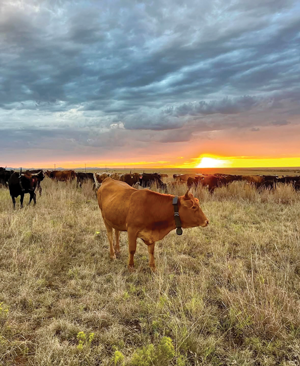 All photos by: Kacie Scherler
All photos by: Kacie Scherler The truth — like most work in agriculture — is more layered. At the heart of our work is partnering with nature to produce goods that benefit our family, our community, the land, and our animals in southwest Oklahoma. That shows up in different ways, whether through no-till farming, adaptive grazing, or selling our beef directly to consumers and through our retail stores. Whatever the outlet, our goal is to create value in ways that leave everything stronger than we found it.
Across our home ranch, leased ground, and management partnerships, we steward about 4,500 acres. Our enterprises are diverse, but we’re primarily a cow-calf operation and raise crops for grazing, as well as for harvesting when conditions are favorable.

Zach manages our farm and ranch while also leading Frontier Ranch Management, a consulting and management company that helps landowners and investors steward ranch assets responsibly. I, Kacie, run Re:Farm and Re:Supply, the direct-to-consumer and retail sides of our business, marketing beef, pork, and grains directly to families, as well as operating a zero-waste refill shop that reduces single-use plastics while strengthening local supply chains.
Together, we also serve as educators with the Noble Research Institute, where we help producers improve their decision making around finances and grazing. What connects all of these efforts is our belief that forage — and how it’s managed — sits at the core of ranch profitability, ecological resilience, and community well-being.
Neither of us grew up with a clear blueprint for what regenerative agriculture looks like in practice. I am a fifth-generation rancher from Walters, Okla., with deep family roots in farming and ranching. I left home to study international development, then returned with a new perspective on how agriculture shapes both people and land. Zach grew up in Uganda, and later moved to Portland, Ore. While not a native rancher, he has grown to love cattle and has a knack for seeing enterprises as systems, along with a stubborn drive to rethink old assumptions.
It’s one thing to talk about principles from the comfort of an office chair but another to live them out in the middle of a drought, when hay prices have doubled, calves aren’t bringing what you’d hoped, or when it would simply be easier to put off moving that polywire. We’ve been there, staring at spreadsheets, watching ponds dry up, moving more polywire in a day than we’d like to admit, and asking ourselves what we overlooked, or whether it’s even worth it.
What we’ve learned is that for our business to be resilient, we have to be adaptive and flexible — which is easier said than done in an industry not known for being nimble. Cash flow is king, but understanding the forage we can grow on our ranch and dialing in on how we can best utilize it is what gives us the opportunity to make smart financial decisions. The ability to measure, monitor, and match stocking rate to carrying capacity is what keeps both the grass and the balance in our bank accounts in check.
Every producer we meet has their own version of the same challenge: How do we turn sunshine, soil, and moisture into money? The crazy thing about ranching is that every location will have a different answer to that question. That’s what makes this industry so diverse and exciting — not to mention dang near impossible to navigate.
Using our resources
We’re part of a generation starting off with unique opportunities and challenges. Land and cattle prices are higher than ever; input costs can swing wildly, but are currently high; and the weather seems to be less and less predictable.
At the same time, we have tools and resources previous generations couldn’t imagine: virtual fence collars, recordkeeping systems, and ag-based apps, plus an endless stream of articles, classes, podcasts, and videos. No farmer or rancher in history has had access to this much information. We look forward to exploring these ideas, sharing both our wins and our failures in hopes that you can borrow what works for us and sidestep a few of the expensive mistakes we’ve made.
As tempting as it is to chase every new tool or technology, there’s often wisdom in what has been done before. What excites us most is finding ways to honor past knowledge while adapting to today’s realities and encouraging others to think critically about how to make decisions that serve both profit and principle.
If there’s one lesson we keep circling back to, it’s that ranching isn’t about control, it’s about partnership — partnership with the land, the weather, the markets, and the people around us. We don’t always get it right, but we’ve learned that transparency, curiosity, and a willingness to adjust go a long way in keeping things moving forward.
Our goal is to explain not only what’s happening on our ranch, but also the frameworks and decision-making tools that help us navigate a complex business. Whether it’s crunching the numbers on economic opportunities, testing annual forage mixes, or experimenting with grazing approaches, we want to be part of your journey and hopefully add a few useful ideas for you to explore along the way.
This article appeared in the November 2025 issue of Hay & Forage Grower on page 20.
Not a subscriber? Click to get the print magazine.

